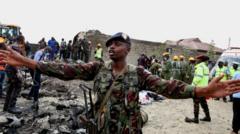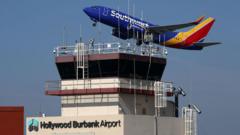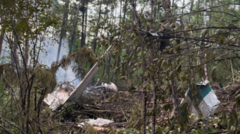The investigation into the Air India Flight 171 crash continues to raise eyebrows as critical details about the incident remain shrouded in ambiguity. The Boeing 787 Dreamliner, tragically, crashed just seconds after takeoff from Ahmedabad en route to London, resulting in the loss of 241 lives onboard and 19 more on the ground, with only one passenger surviving the catastrophe.
In the initial report released by India's Air Accident Investigation Bureau (AAIB), significant findings emerged, particularly concerning the fuel cut-off switches, which were transitioned from 'run' to 'cut-off' right after takeoff. This critical action deprived the engines of fuel and caused a loss of thrust. Although there was an attempt to restart the engines post-manipulation of the switches, it occurred too late to avert disaster.
Despite fulfilling international requirements for a preliminary report, the AAIB's document has provoked extensive debate focused on the actions and communications between the cockpit crew during the incident. Notably, a key exchange was documented where one pilot questioned another about the fuel cut-off action, resulting in confusion and speculation about the motivations behind such a critical switch.
Critics have expressed concern over the report's selective nature. Many industry experts emphasize the absence of a detailed cockpit transcript as a major flaw, restricting the ability to fully understand the nuances of the cockpit conversation. Reports of potentially deliberate actions have incited outrage among pilots, with the Indian Commercial Pilots' Association denouncing implications of pilot misconduct without verified evidence, calling it a breach of ethical journalism.
The lack of transparent information regarding the pilots' interactions and decision-making processes has left many in the aviation community questioning the thoroughness of the investigation. Aviation analyst Bjorn Fehrm and former accident Investigator Tim Atkinson have raised alarms over the incomplete details made public, suggesting it could prevent meaningful conclusions about the crash.
Moreover, the report indirectly references a 2018 safety bulletin issued by the US Federal Aviation Administration (FAA), which outlined risks around the fuel cut-off switches on various Boeing models. Speculation has arisen that Air India's failure to adhere to these advisories may have contributed to the incident, despite the FAA asserting that these concerns did not compromise flight safety.
While the preliminary report provides a foundation for understanding the events of the crash, numerous unanswered questions persist, and observers stress the necessity for comprehensive investigations to ascertain the precise factors leading to such a tragic outcome. As it stands, the final report is not expected to be completed for at least a year, continuing the cycle of speculation and concern within the aviation community.
In the initial report released by India's Air Accident Investigation Bureau (AAIB), significant findings emerged, particularly concerning the fuel cut-off switches, which were transitioned from 'run' to 'cut-off' right after takeoff. This critical action deprived the engines of fuel and caused a loss of thrust. Although there was an attempt to restart the engines post-manipulation of the switches, it occurred too late to avert disaster.
Despite fulfilling international requirements for a preliminary report, the AAIB's document has provoked extensive debate focused on the actions and communications between the cockpit crew during the incident. Notably, a key exchange was documented where one pilot questioned another about the fuel cut-off action, resulting in confusion and speculation about the motivations behind such a critical switch.
Critics have expressed concern over the report's selective nature. Many industry experts emphasize the absence of a detailed cockpit transcript as a major flaw, restricting the ability to fully understand the nuances of the cockpit conversation. Reports of potentially deliberate actions have incited outrage among pilots, with the Indian Commercial Pilots' Association denouncing implications of pilot misconduct without verified evidence, calling it a breach of ethical journalism.
The lack of transparent information regarding the pilots' interactions and decision-making processes has left many in the aviation community questioning the thoroughness of the investigation. Aviation analyst Bjorn Fehrm and former accident Investigator Tim Atkinson have raised alarms over the incomplete details made public, suggesting it could prevent meaningful conclusions about the crash.
Moreover, the report indirectly references a 2018 safety bulletin issued by the US Federal Aviation Administration (FAA), which outlined risks around the fuel cut-off switches on various Boeing models. Speculation has arisen that Air India's failure to adhere to these advisories may have contributed to the incident, despite the FAA asserting that these concerns did not compromise flight safety.
While the preliminary report provides a foundation for understanding the events of the crash, numerous unanswered questions persist, and observers stress the necessity for comprehensive investigations to ascertain the precise factors leading to such a tragic outcome. As it stands, the final report is not expected to be completed for at least a year, continuing the cycle of speculation and concern within the aviation community.

















